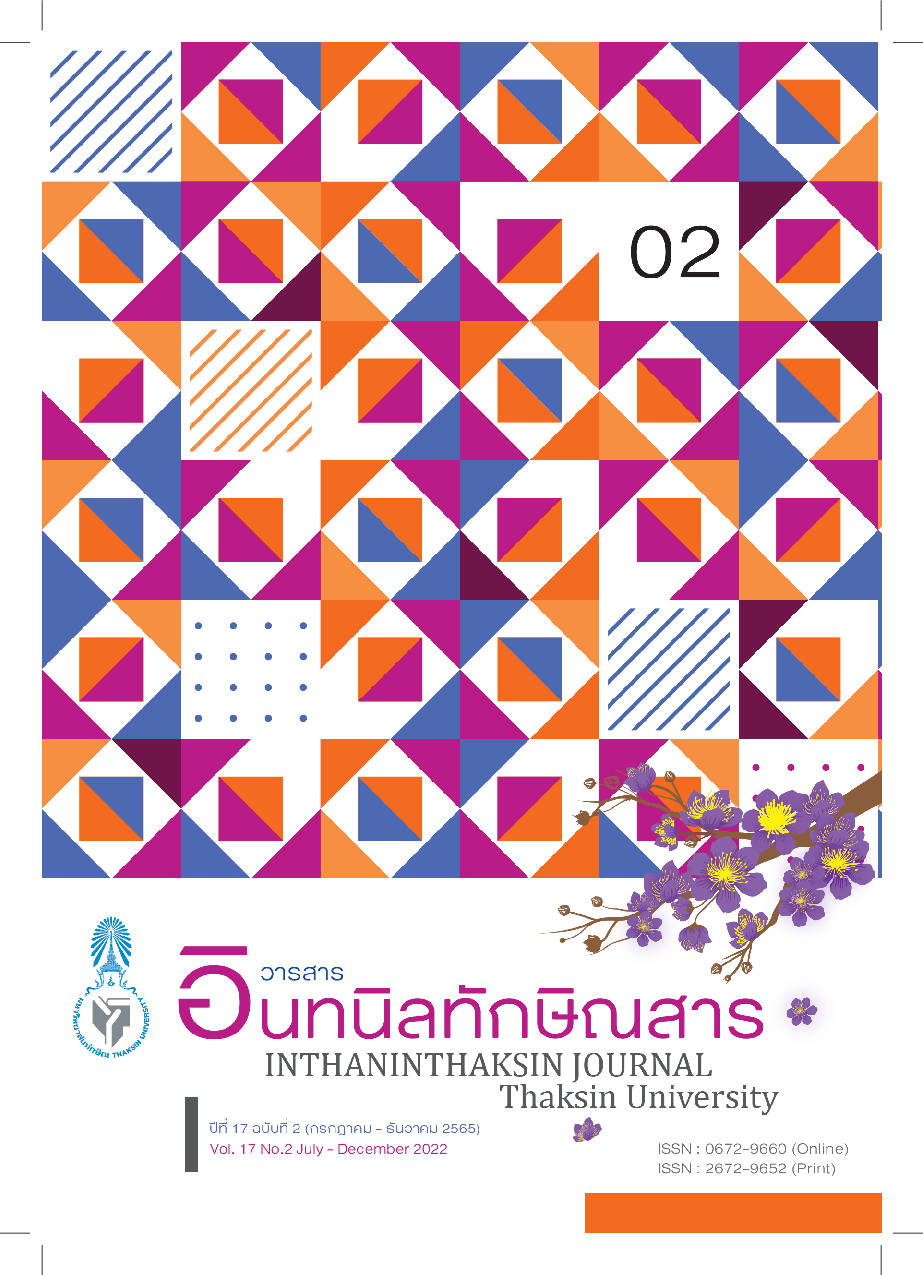ผลของการใช้กลยุทธ์การเขียนเค้าโครงต่อความตระหนักรู้ ในการใช้กลยุทธ์และความสามารถในการเขียนย่อหน้าของ นักศึกษาระดับปริญญาตรีที่เรียนภาษาอังกฤษเป็นภาษาต่างประเทศ
Main Article Content
บทคัดย่อ
การเขียนย่อหน้าเป็นทักษะที่สำคัญและเน้นกระบวนการก่อนการเขียนเพื่อ รวบรวมและจัดการกับความคิด การเขียนเค้าโครงเป็นกลยุทธ์หนึ่งที่ช่วยให้ผู้เขียน จัดการกับความคิดอย่างเป็นระบบและนำไปสู่การเขียนที่มีประสิทธิภาพ ดังนั้น การวิจัยนี้มีวัตถุประสงค์เพื่อ 1) เปรียบเทียบความตระหนักรู้ในการใช้กลยุทธ์ การเขียนเค้าโครงของนักศึกษาที่เรียนภาษาอังกฤษเป็นภาษาต่างประเทศ ก่อนและ หลังเรียนกลยุทธ์การเขียนเค้าโครง และ 2) เปรียบเทียบความสามารถในการเขียน ย่อหน้าของนักศึกษาที่เรียนภาษาอังกฤษเป็นภาษาต่างประเทศ ก่อนและหลังเรียน กลยุทธ์การเขียนเค้าโครง กลุ่มตัวอย่างที่ใช้ ได้แก่ นักศึกษาสาขาวิชาภาษาอังกฤษ จากมหาวิทยาลัยของรัฐแห่งหนึ่ง จำนวน 44 คน โดยใช้วิธีการเลือกแบบเจาะจง เครื่องมือที่ใช้ในการวิจัย ได้แก่ แบบสอบถามความตระหนักรู้ด้านการใช้กลยุทธ์การ เขียนเค้าโครง ซึ่งใช้มาตรวัดแบบลิเคิร์ท 5 ระดับ และแบบทดสอบการเขียนย่อหน้า แบบอัตนัย การวิเคราะห์ข้อมูลใช้ค่าสถิติพรรณนาและค่าสถิติ t-test และรายงานผล ข้ อมู ลโดยใช้ ค่าเฉลี่ ยค่าเบี่ยงเบนมาตรฐาน และค่าt ผลการวิ จัยพบว่า1) นักศึกษา มีความตระหนักรู้ในการใช้กลยุทธ์การเขียนเค้าโครงหลังเรียนสูงกว่าก่อนเรียน โดยก่อนเรียนมีความตระหนักรู้ปานกลาง และหลังเรียนมีความตระหนักรู้ในระดับมาก และ 2) นักศึกษามีความสามารถในการเขียนย่อหน้าหลังเรียนสูงกว่าก่อนเรียนอย่าง มีนัยสำคัญทางสถิติที่ .05 พอสรุปได้ว่า การสอน กลยุทธ์การเขียนเค้าโครงสามารถ พัฒนาความตระหนักรู้ในการใช้และความสามารถในการเขียนย่อหน้าภาษาอังกฤษ ของผู้เรียน ดังนั้น นักศึกษาจำเป็นต้องได้รับการสอนและฝึกกลยุทธ์การเขียนเค้าโครง
Article Details

อนุญาตภายใต้เงื่อนไข Creative Commons Attribution-NonCommercial-NoDerivatives 4.0 International License.
เอกสารอ้างอิง
เจนตา แก้วลาย. (2564). การใช้เทคนิคการสอนแบบสแคฟโฟลดิ่งพัฒนาทักษะ การเขียนความเรียงภาษาอังกฤษของนักศึกษา มหาวิทยาลัยเทคโนโลยี ราชมงคลพระนคร. วารสารรัชต์ภาคย์, 15(43), 69-83.
บุญชม ศรีสะอาด. (2556). วิธีการทางสถิติสำหรับการวิจัย เล่ม 1 (พิมพ์ครั้งที่ 5). กรุงเทพ : สุวีริยาสาร์น.
Arabsarhangi, M. and Noroozi, I. (2014). The relationship between self-awareness and learners’ performance on different reading comprehension test types among Iranian EFL elementary learners, Theory and Practice in Language Studies. 4 (4), 675-685.
Babu, R., Rao, N, and Sridevi, D. (2022). Enhancing writing Skills in ESL learners through the techniques of scaffolding, Volatiles & Essent Oils, 9(1): 47-58.
Boonyarattanasoontorn, P. (2017). An investigation of Thai students’ English language writing difficulties and their use of writing strategies, Journal of Advanced Research in Social Sciences and Humanities. 2(2), 111-118. 103.
Brammer, C. (2007). Peer review from the students’ perspective: invaluable or invalid, Composition Studies. 35 (2), 71-85.
Budjalemba, A.S. and Listyani, S. (2020). Factors contributing to students’ difficulties In academic writing class: Students’ perceptions, UC Journal. 1(2), 135-149.
Crème, P. and Lea, M. (2003). Writing at University (2nd ed.). Philadelphia: Open University Press.
Darus, S. and Subramanian, K. (2009). Error analysis of the written English essays of secondary school students in Malaysia: A case study, European Journal of Social Sciences. 8(3), 483-495.
David, K. (2004). Manage Your Writing. California: Komei.
Donahue, S. (2007). Writing: road-runner English. Indianapolis: MacGraw-Hill.
Duigu, G. (2003). Essay Writing for English Test. Sydney: Academic English Press.
Ellis, G. and Ibrahim, N. (2015). Teaching children how to learn. Surrey: Delta.
Goose, A. (2001). Eight Kinds of Writing: Lesson and Practice for Writing Tests. (2nd ed.). Portland: Weston Walch.
Huy, N. T. (2015). Problems affecting learning writing skill of grade 11 at Thong Linh High School, Asian Journal of Educational Research. 3, 53-69.
Hyland, K. (2003). Second Language Writing. Cambridge University Press, 1-15. Retrieved on December 2, 2019 from http://catdir.loc.gov/cat-dir/samples/cam041/2003041957.pdf
Indriani, K.S. (2019). The effect of outline planning in argumentative essay writing of fourth semester.
Negari, G.M. (2011). A study on strategy instruction and EFL learners’ writing skill, International Journal of English Linguistics. 1(2), 299-307.
Oshima, A. and Hogue, A. (2007). Introduction to academic writing Level 3. (3rd ed.). New York : Pearson Education.
Oxford advance learner dictionary, (2005). Oxford : Oxford University Press.
Padgate. W. (2008). Beliefs and opinions about English editing of students at a Thai university, PASSA. 42, 31-53.
Padmadewi, N.N. and Artini, L.P. (2018). Using scaffolding strategies in teaching writing for improving student literacy in primary school, Advances in Social Science, Education and Humanities Research, 178(1), 16-160.
Pressley, M. (2002). Reading Instruction that Works : The Case for Balanced Teaching (2nd ed.). New York : Guilford.
Rodsawang, S.S. (2017). Writing problems of EFL learners in higher education: A case study of the Far Eastern University, วารสารวิชาการมหาวิทยาลัยฟาร์อีสเทอร์น. 11(1), 268-284.
Sabrina, M. and Sianipar, Y.A. (2012). Improving students’ achievement in writing descriptive paragraph using outline technique, Transform Journal of English Language Teaching and Learning of FBS UNIMED. 3(1), 1-20.
Salija, K. (2017). The effect of using outlines on idea development quality of students essay writings, International Journal of Language Education. 1(1), 11-19.
Susanti, E. (2018). The impact of learning together method-based lesson study on students’ self-awareness in speaking class, Journal of En¬glish Education. 1(2), 31-43.
Tazky, K. (2018). The effect of using outline technique to improve students’ ability
in writing descriptive, Retain. 6(3), 202-210.
Vrugt, A. and Oort, F.J. (2008). Metacognition, achievement goals, study strategies and academic achievement : Pathways to achievement, Metacognition Learning. 3 (2), 123-146.
Vonna, Y., Mukminatien, N., and Laksmi, E.K. (2015). The effect of scaffolding Techniques on students’ writing achievement, Journal Pendidikan Humaniora. 3(1), 227-233.


